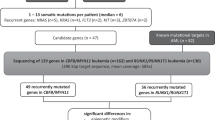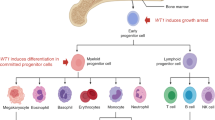Abstract
The roles of CEBPα mutations and its cooperating mutations in the relapse of acute myeloid leukemia (AML) are not clear. CEBPα mutations were analyzed on 149 patients with de novo AML at both diagnosis and relapse. Twenty-two patients (14.8%) had the mutations at diagnosis, two patients had N-terminal nonsense mutations alone, one had homozygous inframe duplication at the bZIP domain, and 19 patients had both N-terminal and bZIP mutations. Twenty patients relapsed with identical mutant patterns, two lost CEBPα mutations and none acquired the mutations at relapse. Cloning analysis showed that the N-terminal and C-terminal mutations occurred on separate cloned alleles and also on the same alleles in most of the diagnosis and relapse samples. Losing one of the two or more mutations on the same allele or acquiring the other mutation on the allele original carrying single mutation were observed not infrequently in the paired samples analyzed. Seven patients with CEBPα mutations had cooperating mutations with FLT3/ITD, FLT3/TKD or N-ras but not K-ras mutations. Our study showed that 91% of de novo AML harboring CEBPα mutations at diagnosis retained the identical mutant patterns but frequently changed in the allelic distribution at relapse.
This is a preview of subscription content, access via your institution
Access options
Subscribe to this journal
Receive 12 print issues and online access
$259.00 per year
only $21.58 per issue
Buy this article
- Purchase on Springer Link
- Instant access to full article PDF
Prices may be subject to local taxes which are calculated during checkout
Similar content being viewed by others
Accession codes
References
Zhang DE, Zhang P, Wang ND, Hetherington CJ, Darlington GJ, Tenen DG . Absence of granulocyte colony-stimulating factor signaling and neutrophil development in CCAAT enhancer binding protein alpha-deficient mice. Proc Natl Acad Sci USA 1997; 94: 569–574.
Radomska HS, Huettner CS, Zhang P, Cheng T, Scadden DT, Tenen DG . CCAAT/enhancer binding protein alpha is a regulatory switch sufficient for induction of granulocytic development from bipotential myeloid progenitors. Mol Cell Biol 1998; 18: 4301–4314.
Pabst T, Mueller BU, Zhang P, Radomska HS, Narravula S, Schnittger S et al. Dominant-negative mutations of CEBPA, encoding CCAAT/enhancer binding protein-alpha (C/EBP alpha), in acute myeloid leukemia. Nat Genet 2001; 27: 263–270.
Gombart AF, Hofmann WK, Kawano S, Takeuchi S, Krug U, Kwok SH et al. Mutations in the gene encoding the transcription factor CCAAT/enhancer binding protein alpha in myelodysplastic syndromes and acute myeloid leukemias. Blood 2002; 99: 1332–1340.
Preudhomme C, Sagot C, Boissel N, Cayuela JM, Tigaud I, de Botton S, et al., ALFA Group. Favorable prognostic significance of CEBPA mutations in patients with de novo acute myeloid leukemia: a study from the Acute Leukemia French Association (ALFA). Blood 2002; 100: 2717–2723.
van Waalwijk van Doorn-Khosrovani SB, Erpelinck C, Meijer J, van Oosterhoud S, van Putten WL, Valk PJ et al. Biallelic mutations in the CEBPA gene and low CEBPA expression levels as prognostic markers in intermediate-risk AML. Hematol J 2003; 4: 31–40.
Frohling S, Schlenk RF, Stolze I, Bihlmayr J, Benner A, Kreitmeier S et al. CEBPA mutations in younger adults with acute myeloid leukemia and normal cytogenetics: prognostic relevance and analysis of cooperating mutations. J Clin Oncol 2004; 22: 624–633.
Shih LY, Huang CF, Lin TL, Wu JH, Wang PN, Dunn P et al. Heterogeneous patterns of CEBPα mutation status in the progression of myelodysplastic syndrome and chronic myelomonocytic leukemia to acute myeloid leukemia. Clin Cancer Res 2005; 11: 1821–1826.
Tiesmeier J, Czwalinna A, Muller-Tidow C, Krauter J, Serve H, Heil G et al. Evidence for allelic evolution of C/EBP alpha mutations in acute myeloid leukaemia. Br J Haematol 2003; 123: 413–419.
Shih LY, Huang CF, Wu JH, Lin TL, Dunn P, Wang PN et al. Internal tandem duplication of FLT3 in relapsed acute myeloid leukemia: a comparative analysis of bone marrow samples from 108 adult patients at diagnosis and relapse. Blood 2002; 100: 2387–2392.
Bennett JM, Catovsky D, Daniel MT, Flandrin G, Galton DA, Gralnick HR et al. Proposed revised criteria for the classification of acute myeloid leukemia. A report of the French-American-British Cooperative Group. Ann Intern Med 1985; 103: 620–625.
Bennett JM, Catovsky D, Daniel MT, Flandrin G, Galton DA, Gralnick HR et al. Proposal for the recognition of minimally differentiated acute myeloid leukaemia (AML-MO). Br J Haematol 1991; 78: 325–329.
Grimwade D, Walker H, Oliver F, Wheatley K, Harrison C, Harrison G et al. The importance of diagnostic cytogenetics on outcome in AML: analysis of 1612 patients entered into the MRC AML 10 trial. The Medical Research Council Adult and Children's Leukaemia Working Parties. Blood 1998; 92: 2322–2333.
Liang DC, Shih LY, Hung IJ, Yang CP, Chen SH, Jaing TH et al. Clinical relevance of internal tandem duplication of the FLT3 gene in childhood acute myeloid leukemia. Cancer 2002; 94: 3292–3298.
Liang DC, Shih LY, Huang CF, Hung IJ, Yang CP, Liu HC et al. CEBP alpha mutations in childhood acute myeloid leukemia. Leukemia 2005; 19: 410–414.
Shih LY, Huang CF, Wang PN, Wu JH, Lin TL, Dunn P et al. Acquisition of FLT3 or N-ras mutations is frequently associated with progression of myelodysplastic syndrome to acute myeloid leukemia. Leukemia 2004; 18: 466–475.
Fu JF, Hsu JJ, Tang TC, Shih LY . Identification of CBL, a proto-oncogene at 11q23.3, as a novel MLL fusion partner in a patient with de novo acute myeloid leukemia. Genes Chromosomes Cancer 2003; 37: 214–219.
Leroy H, Roumier C, Huyghe P, Biggio V, Fenaux P, Preudhomme C . CEBPA point mutations in hematological malignancies. Leukemia 2005; 19: 329–334.
Kelly LM, Gilliland DG . Genetics of myeloid leukemias. Annu Rev Genomics Hum Genet 2002; 3: 179–198.
Mizuki M, Fenski R, Halfter H, Matsumura I, Schmidt R, Muller C et al. Flt3 mutations from patients with acute myeloid leukemia induce transformation of 32D cells mediated by the Ras and STAT5 pathways. Blood 2000; 96: 3907–3914.
Beaupre DM, Kurzrock R . RAS and leukemia: from basic mechanisms to gene-directed therapy. J Clin Oncol 1999; 17: 1071–1079.
Tenen DG . Disruption of differentiation in human cancer: AML shows the way. Nat Rev Cancer 2003; 3: 89–101.
Snaddon J, Smith ML, Neat M, Cambal-Parrales M, Dixon-McIver A, Arch R et al. Mutations of CEBPA in acute myeloid leukemia FAB types M1 and M2. Genes Chromosomes Cancer 2003; 37: 72–78.
Slovak ML, Kopecky KJ, Cassileth PA, Harrington DH, Theil KS, Mohamed A et al. Karyotypic analysis predicts outcome of preremission and postremission therapy in adult acute myeloid leukemia: a Southwest Oncology Group/Eastern Cooperative Oncology Group Study. Blood 2000; 96: 4075–4083.
Schoch C, Schnittger S, Klaus M, Kern W, Hiddemann W, Haferlach T . AML with 11q23/MLL abnormalities as defined by the WHO classification: incidence, partner chromosomes, FAB subtype, age distribution, and prognostic impact in an unselected series of 1897 cytogenetically analyzed AML cases. Blood 2003; 102: 2395–2402.
Acknowledgements
We thank Ms Meng-Chu Chou, Ms Yu-Shu Shih, Ms Huei-Ying Li and Mr Ching-Tai Lee for their excellent technical assistance, Ms Hsin-I Wang for the statistical analysis, and Ms Yu-Feng Wang for her secretarial assistance. This work was supported by Grants NSC92-2314-B-182-026, NSC93-2314-B-182-001 and NSC93-2314-B-195-008 from the National Science Council, Taiwan, Grant MMH-E-94009 from Mackay Memorial Hospital, and Grant NHRI-EX94-9434SI from the National Health Research Institute, Taiwan.
Author information
Authors and Affiliations
Corresponding author
Rights and permissions
About this article
Cite this article
Shih, LY., Liang, DC., Huang, CF. et al. AML patients with CEBPα mutations mostly retain identical mutant patterns but frequently change in allelic distribution at relapse: a comparative analysis on paired diagnosis and relapse samples. Leukemia 20, 604–609 (2006). https://doi.org/10.1038/sj.leu.2404124
Received:
Revised:
Accepted:
Published:
Issue Date:
DOI: https://doi.org/10.1038/sj.leu.2404124
Keywords
This article is cited by
-
Characteristic immunophenotype and gene co-mutational status orchestrate to optimize the prognosis of CEBPA mutant acute myeloid leukemia
Blood Cancer Journal (2023)
-
Molecular and genetic alterations associated with therapy resistance and relapse of acute myeloid leukemia
Journal of Hematology & Oncology (2017)
-
C/EBPα deregulation as a paradigm for leukemogenesis
Leukemia (2017)
-
Overexpression of wild-type or mutants forms of CEBPA alter normal human hematopoiesis
Leukemia (2012)
-
Molecular mechanisms underlying deregulation of C/EBPα in acute myeloid leukemia
International Journal of Hematology (2010)



